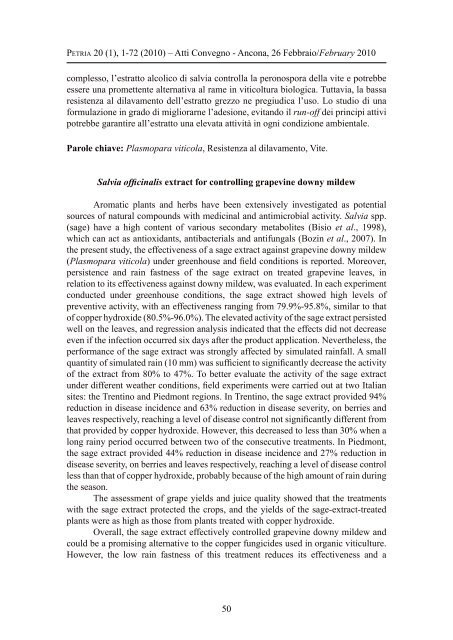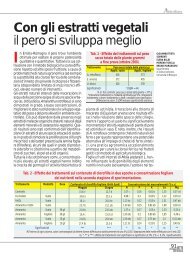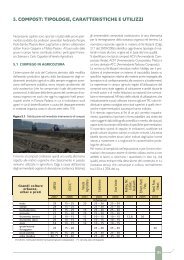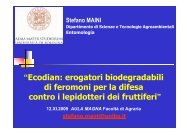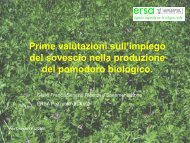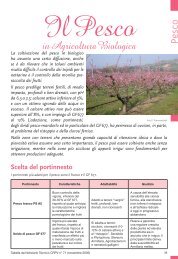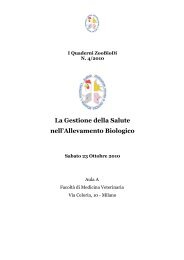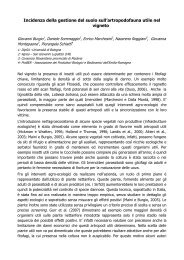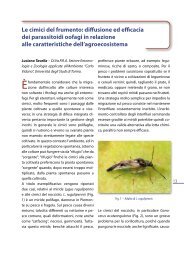Create successful ePaper yourself
Turn your PDF publications into a flip-book with our unique Google optimized e-Paper software.
Petria 20 (1), 1-72 (2010) – Atti Convegno - Ancona, 26 Febbraio/February 2010complesso, l’estratto alcolico di salvia controlla la peronospora della vite e potrebbeessere una promettente alternativa al rame in viticoltura biologica. Tuttavia, la bassaresistenza al dilavamento dell’estratto grezzo ne pregiudica l’uso. Lo studio di unaformulazione in grado di migliorarne l’adesione, evitando il run-off dei principi attivipotrebbe garantire all’estratto una elevata attività in ogni condizione ambientale.Parole chiave: Plasmopara viticola, Resistenza al dilavamento, Vite.Salvia officinalis extract for controlling grapevine downy mildewAromatic plants and herbs have been extensively investigated as potentialsources of natural compounds with medicinal and antimicrobial activity. Salvia spp.(sage) have a high content of various secondary metabolites (Bisio et al., 1998),which can act as antioxidants, antibacterials and antifungals (Bozin et al., 2007). Inthe present study, the effectiveness of a sage extract against grapevine downy mildew(Plasmopara viticola) under greenhouse and field conditions is reported. Moreover,persistence and rain fastness of the sage extract on treated grapevine leaves, inrelation to its effectiveness against downy mildew, was evaluated. In each experimentconducted under greenhouse conditions, the sage extract showed high levels ofpreventive activity, with an effectiveness ranging from 79.9%-95.8%, similar to thatof copper hydroxide (80.5%-96.0%). The elevated activity of the sage extract persistedwell on the leaves, and regression analysis indicated that the effects did not decreaseeven if the infection occurred six days after the product application. Nevertheless, theperformance of the sage extract was strongly affected by simulated rainfall. A smallquantity of simulated rain (10 mm) was sufficient to significantly decrease the activityof the extract from 80% to 47%. To better evaluate the activity of the sage extractunder different weather conditions, field experiments were carried out at two Italiansites: the Trentino and Piedmont regions. In Trentino, the sage extract provided 94%reduction in disease incidence and 63% reduction in disease severity, on berries andleaves respectively, reaching a level of disease control not significantly different fromthat provided by copper hydroxide. However, this decreased to less than 30% when along rainy period occurred between two of the consecutive treatments. In Piedmont,the sage extract provided 44% reduction in disease incidence and 27% reduction indisease severity, on berries and leaves respectively, reaching a level of disease controlless than that of copper hydroxide, probably because of the high amount of rain duringthe season.The assessment of grape yields and juice quality showed that the treatmentswith the sage extract protected the crops, and the yields of the sage-extract-treatedplants were as high as those from plants treated with copper hydroxide.Overall, the sage extract effectively controlled grapevine downy mildew andcould be a promising alternative to the copper fungicides used in organic viticulture.However, the low rain fastness of this treatment reduces its effectiveness and a50


